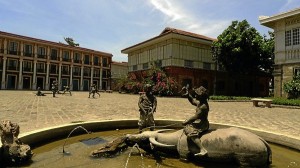Heritage resort modern day’s window to the past
It was a search for a torn, dilapidated house in Bagac, Bataan, that would give birth to what is now heralded as a “living museum,” a heritage resort destination that is truly and uniquely Filipino.
Las Casas Filipinas de Acuzar, the brainchild of Jose Acuzar, chair of property developer New San Jose Builders Inc. (NSJBI), may be a breath of fresh air among other resort destinations as it takes visitors back in time with its authentic 19th century Principalia Mansions and stone houses.
“The story of Las Casas Filipinas de Acuzar started when Mr. Acuzar discovered that an old house he’d been searching for was torn down. Armed with a picture of the house, Mr. Acuzar and his team scoured junk yards to find the pieces of the house,” shared Gina delos Reyes Virtusio, manager for strategic marketing and corporate communications of the NSJBI.
“It took years to recreate and restore the house. It was literally a ‘plank by plank’ and ‘brick by brick’ effort,” Virtusio added.
In fact, the resort was originally meant to be a private family getaway for the Acuzars. Over time however, Bagac, Bataan became the site for the restoration of old, dilapidated houses that Acuzar bought from previous owners. Each house was transplanted completely and rebuilt at its present location.
Today, Las Casas Filipinas de Acuzar spans across a 400-hectare property in Bagac, which rests at the hollow of the Bataan peninsula: between the fine sands of Bagac Bay and the picturesque mountain ranges of Mariveles.
52 hotel rooms
Managed by the Genesis Hotels and Resorts Corp., Las Casas Filipinas currently has 52 hotel rooms, while another 70 rooms are nearing completion.
Guests can meanwhile whet their appetites and satisfy their palates at the traditional Filipino restaurant Marivent Café, tapas bar and deli Taberna del Señor Pepe, and then enjoy a tour at the El Museo artifact museum and art gallery.
The resort likewise showcases 27 traditional Filipino bahay na bato (stone houses) that have been reconstructed or rehabilitated to reflect their original state.
Dubbed as a “living museum,” the resort has many notable structures.
Among these structures would be the Casa Hidalgo, which was lifted from Hidalgo Street in Quiapo, Manila. It was the first location of the University of the Philippines College of Fine Arts.
In its heyday, Casa Hidalgo was frequented by (then UP students) Fernando Amorsolo, Tomas Mapua, Carlos Francisco and Guillermo Tolentino.
Paseo de Escolta, a reproduction of the old commercial district of Escolta, Manila, houses the Casa Escolta, which has 17 hotel rooms. Each hotel room was designed by Acuzar’s wife, Tess, who is an interior designer. The building comes complete with the replicas of the statues that lined the old Escolta buildings.
Visitors can also stay at the dazzling Casa Bizantina, which was Binondo’s first three-story building in 1890. Casa Bizantina housed the precursor of the University of Manila, the Instituto de Manila from 1914 to 1919.
Families can also stay at Casa San Miguel, whose unique features included flower motifs on its galvanized iron window eaves.
360° view of resort
Casa Lubao, which features a 360-degree view of the whole resort and an authentic Atay bed, is also worth a visit, while Casa Biñan, a reproduction of the house owned by the family of Melchora Alonzo is set to become the main museum and art gallery of Las Casas Filipinas de Acuzar.
Another “bahay na bato’’ (brick house), Casa Lemery and an authentic Maranao house are also being added. The Umagol River, which runs through the property to Bagac Bay, will soon have a cathedral on its banks.
All these earned Acuzar an honor at the 8th Annual Tourism Awards hosted by The Rotary Club of Manila for his efforts in developing tourism destination.
Virtusio noted that while NSJBI is known for its mass housing and infrastructure projects, the company’s vision of enriching Filipino families translates into all its projects.
“All our projects are a testament of how deeply committed we are to the Filipino. Transporting these houses and reconstructing them as honestly as possible at Las Casas Filipinas de Acuzar is just one avenue for adding value to the lives of Filipinos,” she explained.
Since its inception in 1986, NSJBI has provided Filipino families with high quality, affordable housing. A pioneer in total vertical integration, all aspects of the company’s projects from architecture, engineering and construction to interior design, marketing and sales are handled by NSJBI.
The absence of subcontractors and the streamlining of developments translate directly into speed of production and savings that homebuyers enjoy.
NSJBI currently has 11 vertical and horizontal projects in prime locations in Metro Manila.
On its 25th year, NSJBI pushes their vision for the Filipino family further by providing venues for health and wellness. The company’s latest developments reflected this: Victoria Station 2 in Quezon City and Victoria de Manila 2 on Taft Avenue in Manila are equipped with 2-hectare sports complexes.



